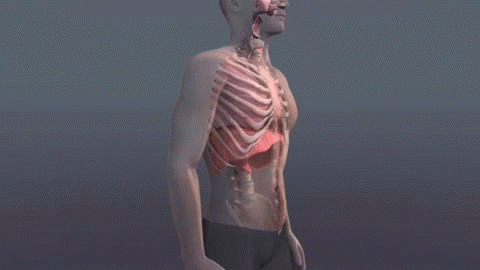The Diaphragm
First of all, we have to know where the diaphragm is and how it moves. The diaphragm is a thin muscle which separates the thorax and the abdomen. It is attached to the lower 6 ribs, breastbone and lumbar spine. It is shaped like a dome and concaves downward.
- Inhalation (active movement):
- diaphragm goes down
- abdomen swells
- at the end, the chest could also swell
- air is pulled into the lungs
- Exhalation (passive movement):
- diaphragm goes back to its initial position without contraction
- the chest pulls back slightly
- the abdomen slides back and up to rest
- Air is forced out
You have to feel a sway-like, wave movement, not a linear one (up/down). For inhalation, your abdominal organs slide down and forward. Exhalation is the passive return of these organs to their initial position. The main point and the most important indicator of the body and mind condition is the quality of the breathing. When we observe a patient breathing, it is an interesting factor to evaluate their capacity to cope with stress.

Source unknown
Situation analysis
The first step is to identify how you breathe and what you feel when you breathe. Let us begin:
1.Find a place where you feel quiet and relaxed.
2.Take 5 minutes to stay seated and just try to feel how you breathe. You can close your eyes to increase your focus on your breath. When you are ready, answer these questions:
– What parts of my body move, and when?
– Are movements free and easy or hard and jerky?
– Where does the air pass? Through my nose or my mouth?
– How many breathing cycles do I perform per minute?
– Do I feel tension or pain somewhere?
– Is my inhalation and exhalation equal?
– Is it pleasant or unpleasant?
– Is it difficult for me to stay focused on my breathing?
3.It will be interesting to note your responses as you will be able to compare them after training.
As with every muscle of your body, the diaphragm can be trained with specific exercises. Next, we will learn how to use your diaphragm properly, providing tone and strength to help maintain the positive effects of quality breathing for a long time. The following exercises are devoted to teach you how to breathe properly, step by step, by following a smart progression. You will be able to improve your physical and mental condition. If you are interested, please click here.
